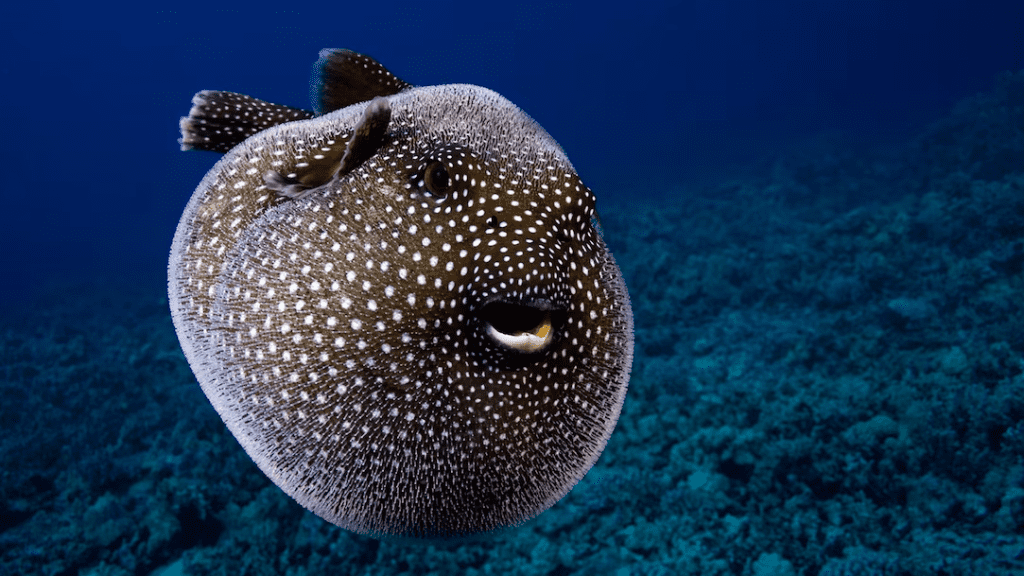A day at the beach turned into an unexpected mystery when a young man stumbled upon a peculiar round object that looked like a fruit. Thinking he had found an unusual tropical snack, he snapped a photo and posted it online as a riddle. Little did he know, he had just discovered one of the ocean’s most deadly creatures in disguise—a pufferfish.
What seemed like an innocent beach discovery quickly took the internet by storm, leaving thousands stunned when the truth behind the “fruit” was finally revealed.
A Bizarre Find on the Shore

Imagine strolling along the beach, feeling the warm sand beneath your feet, when you suddenly spot something round and smooth, resembling a melon or a deflated ball. That’s exactly what happened to a curious beachgoer who picked up the odd-looking object and turned to social media for answers.
At first glance, it looked harmless. It had a slightly rough texture, a pale hue, and appeared to have been dried out by the sun. Could it be an exotic fruit? A rare type of sea coconut? Guesses flooded the comments section, ranging from amusing to downright bizarre.
But then, a marine biologist chimed in with an alarming truth: This was no fruit—it was a dried-up pufferfish.
Pufferfish: A Deadly Wonder of the Ocean
Pufferfish, also known as blowfish or fugu, are among the most fascinating yet dangerous marine creatures. While they may appear cute and even comical when inflated, they harbor a deadly secret—a powerful neurotoxin that can be fatal to humans.
The Ultimate Defense Mechanism
One of the most well-known traits of a pufferfish is its ability to inflate itself like a balloon when threatened. By swallowing water or air, the fish dramatically increases in size, making it harder for predators to swallow. Some species even have sharp spines that protrude when they puff up, acting as an extra layer of protection.
But the real danger doesn’t come from their spikes—it comes from what’s inside them.
The Hidden Danger: Tetrodotoxin Poisoning
Pufferfish are notorious for containing tetrodotoxin, a lethal substance that is 1,200 times more toxic than cyanide. This potent neurotoxin targets the nervous system, leading to:
- Numbness and tingling around the mouth and extremities
- Muscle paralysis and difficulty breathing
- Death in severe cases, often due to respiratory failure
Even a tiny amount of tetrodotoxin can be fatal. What’s even more terrifying? There is no known antidote.
How This “Fruit” Almost Became a Deadly Mistake
The young man who found the dried pufferfish had no idea how dangerous it was. If he had tried to cut it open or handle it carelessly, he could have exposed himself to the deadly toxin. Some people in the comments even joked about taking it home or biting into it—a mistake that could have had serious, if not fatal, consequences.
Luckily, after learning the truth, he quickly disposed of it, warning others about the unexpected dangers that can wash up on shore.
Pufferfish as a Delicacy: Fugu in Japan
Despite their deadly reputation, pufferfish remain a highly sought-after delicacy in Japan, where they are called fugu. However, preparing fugu is not for the faint-hearted.
Only licensed chefs who undergo years of rigorous training are allowed to serve fugu in Japan. One small mistake in preparation—accidentally cutting into the toxin-containing organs—could turn a high-end meal into a deadly dish.
It’s no surprise that eating fugu is considered a thrill-seeking experience, with diners trusting that their chef’s expertise will keep them safe.
Where Are Pufferfish Found?
Pufferfish are commonly found in tropical and subtropical waters across the Atlantic, Indian, and Pacific Oceans. They prefer:
- Shallow coastal areas
- Reefs and mangroves
- Sandy seabeds where they can camouflage
They primarily feed on algae, small crustaceans, and mollusks. Thanks to their powerful, beak-like teeth, they can easily crush shells, allowing them to access food that other fish cannot.

Weird but True: Fun Facts About Pufferfish
Pufferfish are one of the ocean’s most unique creatures, and there’s more to them than meets the eye:
- Over 120 species of pufferfish exist worldwide.
- Some species have bright colors, acting as a natural warning sign for predators.
- Dolphins have been observed playing with pufferfish, possibly to get a “high” from their toxin.
- Pufferfish moms carefully prepare “nests” by creating intricate circles in the sand to attract mates.
- Their toxin is not produced naturally—they accumulate it from their diet, mainly bacteria in the marine environment.
The Importance of Admiring From Afar
While pufferfish are undoubtedly fascinating creatures, they are also a reminder of nature’s power and unpredictability. Whether washed up on shore or swimming peacefully in the ocean, they should be observed with caution and respect.
For beachgoers, the lesson is clear: Not everything that looks harmless is safe. Sometimes, the most unassuming discoveries—like a round, dried-up “fruit”—can be far more dangerous than they seem.
Final Thoughts: A Shocking Beach Discovery Turned Life Lesson
What started as an amusing beach mystery quickly became a viral sensation, proving that nature is full of surprises. A simple mistake—mistaking a dried pufferfish for an edible fruit—could have led to serious consequences.
The next time you find something unusual on the shore, think twice before touching it. The ocean holds many wonders, but some, like the deadly pufferfish, are best admired from a safe distance.


